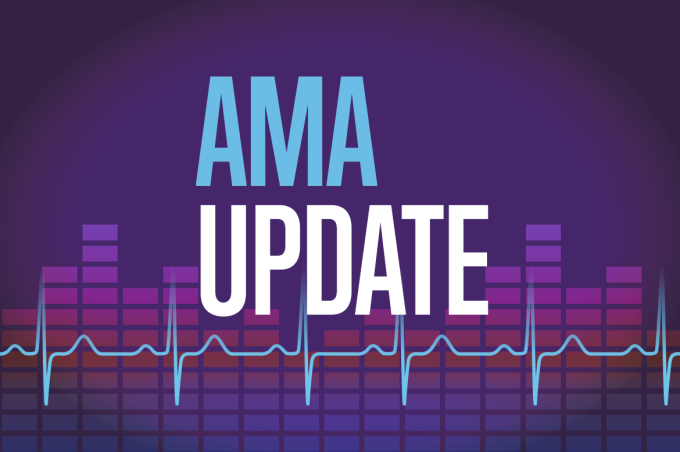AMA Update covers a range of health care topics affecting the lives of physicians, residents, medical students and patients. From private practice and health system leaders to scientists and public health officials, hear from the experts in medicine on COVID-19, medical education, advocacy issues, burnout, vaccines and more.
Featured topic and speakers
What is translational science? How is AI used in health care? What is JAMA+ AI in medicine? How long does it take to publish a study in JAMA? How many journals does JAMA publish?
JAMA® Editor-in-Chief Kirsten Bibbins-Domingo, MD, PhD, discusses her priorities for JAMA this year, the launch of JAMA+ AI and Translational Science Reviews, and what’s still to come in 2025. AMA Chief Experience Officer Todd Unger hosts.
- Watch AMA Update for health care news for physicians, residents and medical students.
- Not a physician? Join the Patients Action Network.
- Get the latest on AI in health care research from JAMA+ AI in medicine journal.
- JAMA® login.
- JAMA Network™ Open
- The AMA is your powerful ally, focused on addressing the issues important to you, so you can focus on what matters most—patients. We will meet this challenge together. Join us.
- Learn more about our AMA advocacy priorities, including:
- Reforming Medicare payment
- Fighting scope creep
- Fixing prior authorization
- Reducing physician burnout
- Making technology work for physicians
Speaker
- Kirsten Bibbins-Domingo, MD, PhD, editor-in-chief, JAMA® and JAMA Network™
Transcript
Dr. Bibbins-Domingo: That's what's exciting. I think we are going to see AI transforming, how we discover new drugs, new therapeutics, new interventions. And we're going to see it all the way through to increasing access for people who might not have access to information or access to care.
Unger: Hello, and welcome to the AMA Update video and podcast. Today, we're checking in with JAMA® Editor-in-Chief Dr. Kirsten Bibbins-Domingo, about the latest updates from JAMA, and what's on the horizon for the publication this year. I'm Todd Unger, AMA's chief experience officer. Dr. Bibbins-Domingo, it's so great to have you here.
Dr. Bibbins-Domingo: It's great to be here again.
Unger: It is always so much fun to hear what you're up to at JAMA. There are always a million things happening. You move at such a fast pace. I know, it's the—close to the beginning of the year—
Dr. Bibbins-Domingo: Yes.
Unger: --but I'm curious to know, what are the key priorities for 2025?
Dr. Bibbins-Domingo: Great. So JAMA Network has 13 journals, and we publish great content. Most of our journals are the leaders in their respective fields. But we want people to be able to find that content. We know doctors are on their phones. They're finding things in places, on social platforms, on other things.
So a big push for us this year is, how do we amplify our content? How do we make it easier for people to find the things that they're looking for? And we have a lot of initiatives there. We're really pushing on our global outreach. Of course, we're based here in Chicago, and we publish. We have a big U.S. audience. But we want the best science wherever it is across the globe.
And readers love the content from JAMA® and the JAMA Network™ journals, so we want to always make sure they have access.
And then the third thing is we want to be faster, because authors want their work out as quickly as possible, and readers, who want to benefit from that work, want to read it when they want to read it. And we want to be faster without compromising our standards. So those are our three big pushes this year.
Unger: So basically, global digital powerhouse.
Dr. Bibbins-Domingo: Exactly.
Unger: Have I summarized this correctly? OK.
Dr. Bibbins-Domingo: You're so good at that.
Unger: There we go. I like it. You know, it's March, I guess, what—
Dr. Bibbins-Domingo: Yes.
Unger: —what have the big things been so far this year?
Dr. Bibbins-Domingo: Yeah. So in March, I came back two weeks ago from the top university in Mexico, that's part of our in-person global roadshows that we've been doing. Last year, we did a tour in Asia and in the UK. There's more on the horizon, in Canada and other parts of Europe and in Asia, again. That's a little bit sort of in-person.
I'll tell you the thing that I love about those trips is just how resonant the JAMA brand is, the AMA brand is, and just interacting with scientists around the globe, talking about science. So that's been really energizing for us. Our teams are getting faster. We already see signs of that happening.
And we're thinking about new products we're going to be launching this year that we're excited about. Just different ways to think about the same content that we publish.
Unger: Well, that's a great segue, because one of the new things that you're working on is around the hottest topic right now everywhere, which is AI.
Dr. Bibbins-Domingo: Yes.
Unger: Tell us about that.
Dr. Bibbins-Domingo: Yeah. So last year, we launched a channel JAMA+ AI, and JAMA+ AI is an experience for the reader who wants to find the AI content across our network, but may not want to read every single journal for that AI content. So we have curated that content.
We've created an experience around that with more explanation about the content. We have a podcast that's devoted totally to AI and its impact on how we practice medicine.
And it really—our thought here was to grow the audience. We want people not just—we want to draw people in who know and understand AI, and people who are a little curious and want to learn a little more. They can come to JAMA+ AI and do all that. Explore our content.
Unger: I'm curious about, you know, what have you seen so far? I was just reading something earlier this week about AI being used to identify existing medications that might treat rare diseases, and I was like, wow, that's amazing.
Are there any other kind of things that you've seen in the hopper thus far that get you excited?
Dr. Bibbins-Domingo: Yeah, there are so many things. That's what's exciting. I think we are going to see AI transforming how we discover new drugs, new therapeutics, new interventions. And we're going to see it all the way through to increasing access for people who might not have access to information or access to care.
We're seeing the ability to actually do so many more things remotely through AI, so that the point-of-care ultrasound might be able to be utilized in a person who's very remote from a doctor's office before they get there. We've published on this in JAMA.
We also have seen—JAMA+ AI just published a podcast talking about how to make health information accessible for people with intellectual disabilities, for example. And one of the cool things I liked in that particular interview is that they showed examples of AI-derived text that was written for people, so that it might be more accessible.
So lots of different use cases. What we want to see is the science that tells us that these are actually better and/or actually help in the way that we ultimately want for patients. But it's a very exciting area.
Unger: Well, I'll be excited to see more of that. One of the other things that you've launched is something called Translational Science Reviews.
Dr. Bibbins-Domingo: Yes.
Unger: What does that mean?
Dr. Bibbins-Domingo: You must be reading JAMA, Todd.
Yeah. So translational science is really interesting. So what's interested me in this environment right now is just that there's an explosion of new discoveries and application of discoveries in the lab to actually new things that actually benefit patients. And so probably, anybody who's worked in a hospital or who might have somebody close to them who has cancer, knows that CAR-T cells are what people are talking about as these innovative treatments for conditions that we've not had treatments for in the past.
And they really—the basis for them is some very interesting biology. And so these translational reviews are designed for clinicians. They're designed for people who might not have a lot of expertise in CAR-T cells, it's not their area of focus, but to explain, how do CAR-T cells work? What does it mean when you get a treatment with CAR-T cells?
We have great illustrators at JAMA that really have produced some wonderful illustrations to help explain how CAR-T cells actually work. And I think the thing I loved about it is that we've had a lot of readers comment that they like this review, and we have people who work in the area of CAR-T cells say, yeah, that's a pretty good review. It's on target.
Unger: So is the translational part of that, it's like basically translating the research part of it into something that is, what does this really mean, with the hopes that maybe it would truncate that discovery to application process, which can take, as I understood it, used to be like 17 years?
Dr. Bibbins-Domingo: Yeah, that's a great way of thinking about it. I think translation is used in that way to think about this bench to bedside, the lab bench to the bedside.
And I think what we thought our niche was at JAMA is to say there are many things that are new, but are already really are at the bedside. And we want to bring more people into that window of the discovery to the bedside, so that more people who are interested, have the expertise, can understand what it is, because it's something that's really going to benefit all of us, whether we're clinically practicing or because it affects the health of so many people we'll take care of or ourselves.
Unger: I think you better trademark discovery-to-bedside as quickly as possible. But you said, physicians, obviously, I would think would really like something like that. What's been the feedback so far?
Dr. Bibbins-Domingo: It's been so positively received. We have one of our board members who called me right away, literally within half an hour of us publishing, and said, I've been waiting for you all to do this.
And I think we believe part of our niche is being able is—is to be able to be true to the actual scientific discovery. But ourselves do that translation, used a different way, for anybody who might have an interest in medicine or health, particularly those in clinical practice.
Unger: Well, that's a lot for March of this year.
Dr. Bibbins-Domingo: Yes.
Unger: As you look to the balance of the year, what kind of stands out in your mind as the big things you want to accomplish?
Dr. Bibbins-Domingo: Oh, there's a lot. I think just because there's so much great science, I think the three themes won't change. We will be traveling to many places to talk about JAMA, we'll be continuing to make our journals as quick and responsive as possible, and we will be amplifying our content, probably with new channels, but I'm not quite ready to tell you all of those yet.
But in the meantime, there's great science happening in Alzheimer's disease, in nutrition, actually, and in—We just published a study on vitamin D and multiple sclerosis—in obesity, and in so many other areas. So we are looking not only to publish that great science, but to tell the stories about the science through other types of our multimedia platforms.
So there's a lot that's going to go on during this year. We're excited about it just because it's an exciting time to publish science.
Unger: I love how you're making that science accessible and that translation into practice and building—You heard it here first—global digital powerhouse—
Dr. Bibbins-Domingo: I love it.
Unger: —at JAMA. Fantastic. Dr. Bibbins-Domingo, thank you so much for being here. Always a pleasure to talk to you. With an AMA membership, you get unlimited access to the JAMA Network and only AMA members receive the JAMA print edition. To become a member, visit ama-assn.org/join.
That wraps up today's episode, and we'll be back soon with another AMA Update. Be sure to subscribe for new episodes, and find all our videos and podcasts at ama-assn.org/podcasts. Thanks for joining us today. Please take care.
Disclaimer: The viewpoints expressed in this podcast are those of the participants and/or do not necessarily reflect the views and policies of the AMA.




